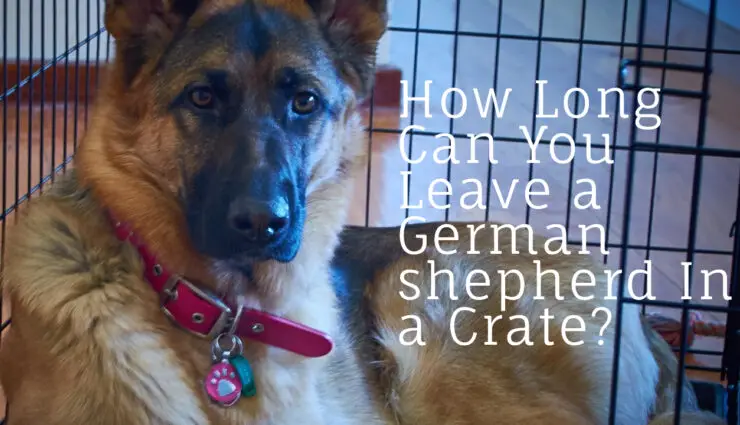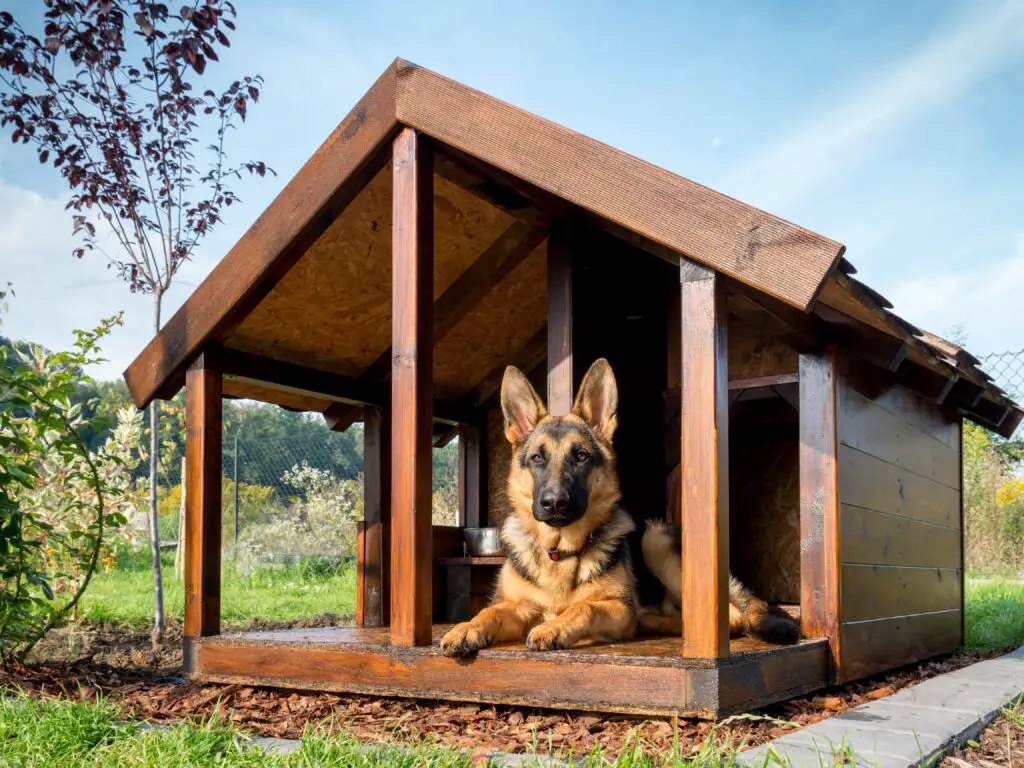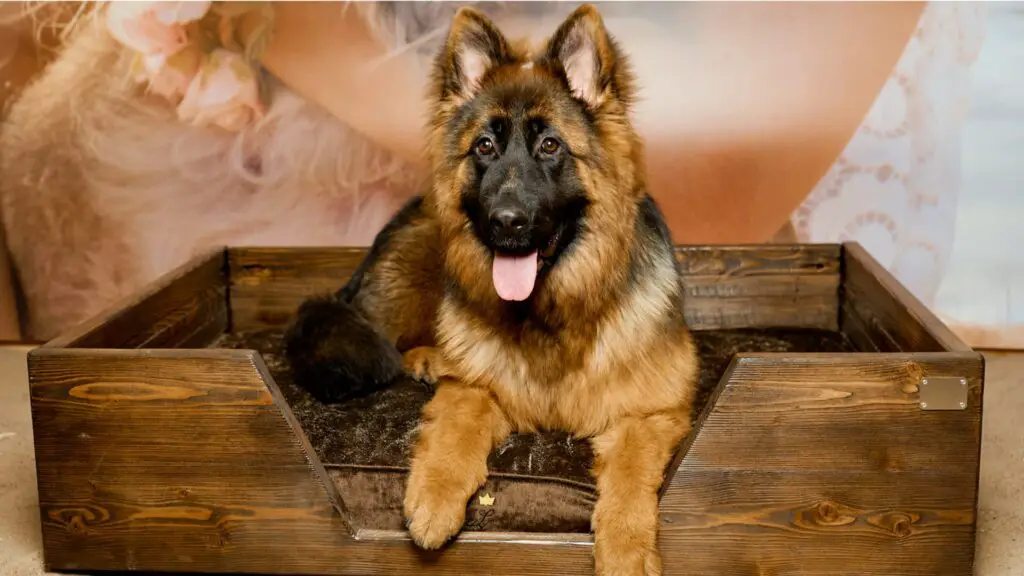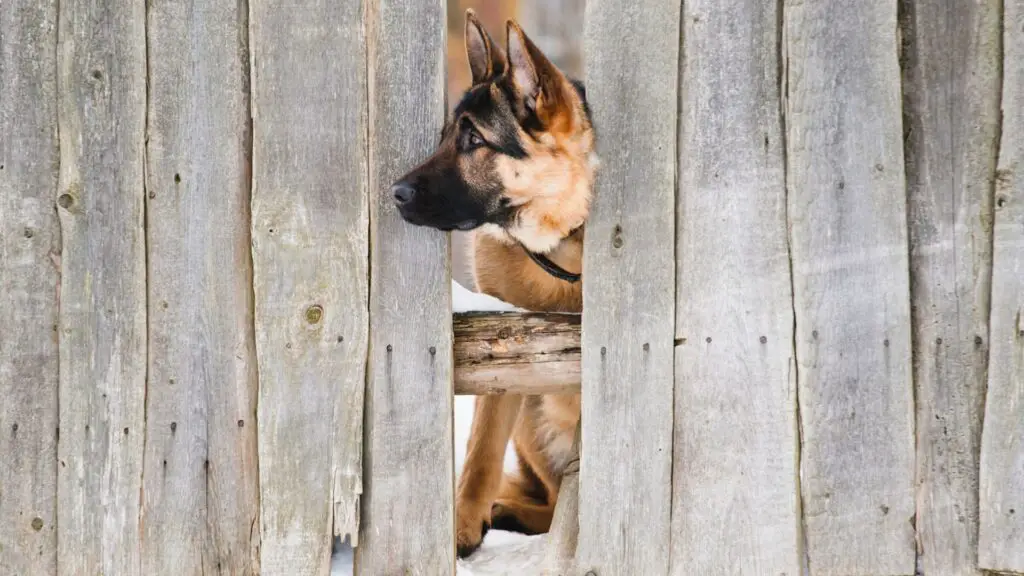One of the puzzling questions that most people enquire about putting a dog in a crate is how long one can leave his German shepherd in a crate.
German shepherds are high energy dogs that thrive well in a spacious area. Additionally, they love the attention they get from us humans. So leaving your German shepherd for too long in a crate can predispose it to a host of physical and mental abnormalities.
So, knowing when to put a limit is always vital for every dog owner.
So, with that said, let’s dive in and check when it’s appropriate to let your German shepherd out of the crate and much more.
How Long Can You Leave a German shepherd In a Crate?
The duration that you should leave your German shepherd in a crate depends on his age.
Here is a guide that can help tell you when to open that cage and let your German shepherd roam outside freely.
| Age | Time inside a crate |
| 8-10 weeks | 30-60 minute |
| 11-14 weeks | 1-3 hrs. |
| 15-16 weeks | 3-4 hours |
| 17 weeks and above | 4 -5 hrs. |
The above table should work as a guiding tool for you.
Furthermore, this guide table can change in the case your dog is ill or other unprecedented factors.
How Long Is Too Long to Crate a German shepherd.
As earlier discussed the German shepherd is a masculine dog with herding instincts on its system. So, leaving this dog that has lots of energy to dispense for a long duration won’t prevail well with your dog.
It’s advisable not to leave a German shepherd in a crate or a kennel for more than 4 hours a day. The more hours you leave your German shepherd inside the crate, the closer it is to physical and mental health issues.
Here are some issues associated with prolonged stay for German shepherds inside a crate.
Effects of Prolonged Stay in a Crate for a German shepherd
Separation Anxiety
German shepherds are affectionate canines that attach themselves to their owners. So leaving them in a crate alone for a long time can affect their emotional wellbeing. Separation anxiety is one of the prevalent issues.
Separation anxiety may present with other behavioral problems anxiety digging and much more.
Such dogs that develop separation anxiety require the help of an animal behavior expert.
Hip and Elbow Dysplasia
The German shepherd needs 2 hours of exercise daily. Thus exercises, come in handy if you want a physically and mentally healthy Canine.
Lack of exercise and confining this dog in a small space like a crate will not work well with the German shepherd joints.
This joint disease is painful and can immobilize a dog.
Puppy Toileting Issues
Puppies have small bladders, and they may find it hard to hold it for long if not let outside. Overstaying in a crate will entice a puppy to leave its small accident inside the crate. And if the puppy becomes accustomed to relieving itself inside the crate- it will be hard to weed out such behavior.
Heart Issues
Lack of exercise in a German shepherd can predispose it to some cardiovascular-related diseases.
Often occurs when the dog packs more weight, thus overburdening the heart in terms of pumping blood.
Other condition that may occur if you crate a German shepherd for long
- Eating disorders
- Depression
- Muscle atrophy
- Obsessive-compulsive disease
- Anxiety
- Hyperactivity
- Excessing whining
How to Crate a German shepherd Puppy
With everything said regarding crating a dog like the German shepherd, what’s the best crate training procedure? Is it a tiring process? How long does it take for a German shepherd to get fully crate trained?
Let’s dive and have a look.
Basic items you should have:
- A sizeable crate
- Some treats
- Comfy bed
- Feeding bowl
- Blanket (optional)
The Introduction
First, have the crate’s door opened or removed temporarily.
Secondly, sit near the crate with your dog. Next, allow it to enter inside without pushing the dog.
Some dogs will gladly enter the crate and lay inside without a hassle.
However, some will need an extra push (not the physical push) remember we don’t want to become pushy or else the dog will associate the crate with negative experiences.
If your German shepherd needs a little help, here is how you should do it.
Familiarization Stage
Put the crate in an area where the dog loves to stay. Not far away from main house activities.
Open the crate’s door and let the German shepherd puppy familiarize itself with the crate. Toss some treats inside the crate and let the puppy fetch them.
Repeat the same procedure twice a day and remember to be patient and don’t show any aggression if your German shepherd is reluctant to get inside.
You can call it off for that day and try it the following day if the puppy is reluctant to enter the crate.
The Second Step (Mealtime inside the Crate)
After completing the first stage, it’s time to head over to the next schedule. Let your German shepherd take its meals inside a cage.
First, don’t be in a rush. Let the peppy eat its food near the crate. Next, during the next feeding session, push the feeding bowl near the entrance, and watch how your dog reacts.
Latter, push the feeding bowl more inside. If the puppy is reluctant to feed, pull the bowl closer.
All in all, sometimes you will note that your German shepherd will accept the idea of eating its food inside a crate.
Next, shut the door while your puppy is inside the crate while it’s eating. Don’t open the crate till your puppy is full.
Let the puppy rest for 10 minutes and then open the cage.
Do the same routine for the next 3-5 meal times.
Continue adding some minutes before opening the cage for your puppy, for example, add 5 minutes. If you note your puppy whining, you could have increased the length so consider shortening it in the next feeding session.
Leave the Scene
After you have let your German shepherd inside its cage, it’s time to leave it for a short period.
You can go next room, let’s say in your kitchen. Check at it after 30 minutes.
Alternatively, do your laundry or read a book in a place where your dog can see you. That way, the dog won’t associate the crate with anything negative experiences.
Practicing German shepherd Crating Using a Command
Now that your German shepherd is almost through with his crate training class, it’s time to introduce a command.
A command like ‘get in’ or ‘into your crate’ will suffice.
First, call out your dog’s name and give him a treat.
Point at the crate and let out the command you have chosen. For example, get in.
Caution, don’t bang the crate or use a high-pitched tone.
If the German shepherd obliges to your call, reward him using a treat.
After the puppy is inside, sit nearby for 5-10 minutes, then move next room. Stay for like 10 minutes away without peeping or calling your dog’s name. Then go back near the cage and sit right close to it.
Do such a process severally in a day.
Gradually, increase the duration you stay away, for let’s say 10, 20, 30 minutes in that sequence.
Crate Training at Night
Crate training at night is not that special or that gruesome. It all requires diligence.
For puppies, ensure they have taken their meals 3 hours before bedtime. Also, ensure they have a potty after they have had a meal. Next, ensure they have had a small exercise session.
For adopted puppies or any other puppy, place the crate near your bed. There you will assure your puppy that you are still there.
If your puppy whines, you can stretch your hand on its crate or let out a cough. Such a reaction will reassure the puppy that all is well.
If the puppy whines or barks a lot, take it outside to potty. If it had a potty, let us say 30 minutes ago, don’t open the cage for it.
By doing so, the puppy will associate whining with being let out of the cage.
So be sure to discern what causing the whining. I know it can be challenging for any pet owner. But you will have to do this judgment, whether to open for your puppy or not.
What Should I Put Inside A Crate?
A Sizeable Crate
Use a crate that is enough for your dog to rest, flex, and move without hurting itself. But not that spacious, at least it will soil one end of the crate.
Anti-Chew Bedding
A crate should be comfortable for your dog daily. So get some anti-tear beddings.
Toys
Imagine yourself enclosed in a dark empty room, no phone or any other gadget to keep you engaged. That’s how it would feel for your puppy if in a crate for long without anything. Make your puppy busy by letting him play with safe toys.
For example, if you are going outside for more than an hour. You can stuff a toy with treats and freeze it to keep the puppy engaged as you do your things.
Alternatively, you can purchase a treat-dispensing camera.
This camera helps spy on your dog as well as keep the dog engaged by tossing treats.
When Should I Not Crate My German shepherd?
Inappropriate Size of the Crate
Don’t crate a German shepherd in a crate smaller than his size.
Your Dog Is Sick
Crating an ill German shepherd is animal cruelty. You will be torturing your dog if you crate it for long.
The Dog Suffers From Separation Anxiety
Crating a German shepherd suffering from separation anxiety will escalate the situation more than becoming of help.
Instead, look for an animal behaviorist before getting into the idea of crate training your German shepherd.
Dogs Won’t Stop Eliminating Inside the Crate
Your dog won’t stop defecating inside the crate even after following all protocols. Then you drop the idea of crating your German shepherd and source for other avenues of helping your dog.
Other Alternatives.
Dogs are individuals, and what has worked on your neighbor’s dog is not justified that it will work smoothly on your dog.
So if your work for long hours a day, here are other helpful options besides using a crate that will be fruitful.
Go with Your German shepherd To Your Workplace
Does your workplace allow one to come with a pet? Then why don’t you carry your dog with you at work?
However, this idea will only work if your dog is trained and well behaved.
A Dog Walker
Dogs like German shepherd require several play sessions to keep them fit and healthy. However, if you live alone or work for long shifts, it would turn out to be hard to quench your German shepherd exercise needs.
You can get a pet walker or a dog sitter who will help exercise your dog.
You can also request your friend or family member to come and check up on your dog.
Doggy Daycare
Dog daycares come in handy if you don’t want to leave a German shepherd in a crate. Furthermore, dog daycare will help mold your dog socially.
Come Home for Lunch
If unable to find a pet walker, you can decide to drop for your lunch in your house. Whereby you will monitor your dog and also give your dog a short play session. With that, it’s less likely that your dog will suffer from separation anxiety.
Get a Playpen
Playpens can help restrict your dog’s movement. Partition the area you want your dog to hover freely. However, an athletic and energetic dog like the German shepherd can run over the pen with ease.
Work from Home
You can decide to work from home if all seem not to work. Such a good idea as you will be in a better position to monitor your dog with ease.
Should You Cover a German shepherd Crate with a Blanket?
Whether to cover a German shepherd crate or not will entirely depend on your dog’s prevalence. Some dogs prefer a darkened place, whereas others dislike such an idea.
Covering the crate of a German shepherd can help calm its nerves.
You can decide to cover the whole part of the crate, i.e. the top, and the sides.
If your dog presents with some signs of dissatisfaction, it is time to stop it.
The guidelines to follow if you have to cover with a blanket.
- Use a breathable blanket- don’t use a stuffy blanket that won’t let air flow freely inside.
- Ensure the temperatures are not too hot as you leave a German shepherd in a crate. The German shepherd may find it hard to withstand high temperatures.
- Ensure the fabric you use is not near the fireplace- you all know what would happen if the blanket catches fire.
- Next, don’t insist on putting a blanket over the cage if your dog is not comfortable.
How Long Should a German shepherd Sleep?
A healthy German shepherd should have 12-14 hours of sleep. Nevertheless, it all trickles down to the age of the German shepherd.
German shepherd puppies and the young will tend to have long sleeping sessions. Working German shepherds who are always engaged, tend to sleep less than the show line German shepherds.
Why Is My German shepherd sleeping for Long?
Illness
A sick German shepherd will tend to sleep more.
Your Dog Is Ageing
An older dog tends to sleep more as compared to teens.
The German shepherd Is Sleeping Too Little
The German shepherd Has Lots of Energy
A German shepherd is a masculine dog that requires several exercise session to burn up its pent up energy.
Lack of exercise will lead to a buildup of unused energy- thus causing your dog to sleep little.
Your Dog Is Sick
Some health conditions like arthritis can cause excruciating pain thus causing your dog to have short sleeping sessions.
Anxiousness or Separation Anxiety
Similar to human beings an anxious German shepherd will barely have enough sleep.
Sleeping Disorders Common in German Shepherds
Insomnia
Likewise, to human beings, dogs like the German shepherds can have insomnia. And it’s often caused by a host of factors.
Your veterinary may prescribe melatonin supplements for your dog.
Sleep Apnea
The hallmark of sleep apnea is the involuntarily stopping of breathing while the dog is sleeping. The dog may produce a horrifying sound as the airways open up.
Frequently Asked Questions
Is It Wrong to Put My German shepherd Inside a Crate?
It’s never wrong to leave a German shepherd inside a crate. It all matters on the duration you have left it inside.
Check on the previously outlined table and see for how long you should leave your German shepherd.
What Happens If You Leave Your German shepherd In a Crate for Long?
Leaving a German shepherd in a crate for too long is not recommended. If you leave it for long, it can potty inside or even develop separation anxiety.
Conclusion
Never leave your German shepherd in a crate for more than 4 hours. Its cruelty and may lead to the development of mental and physical health issues on your dog.
Nevertheless, always let the dog associate a crate with a positive experience. Additionally, never use a crate as a form of punishment for your German shepherd.





